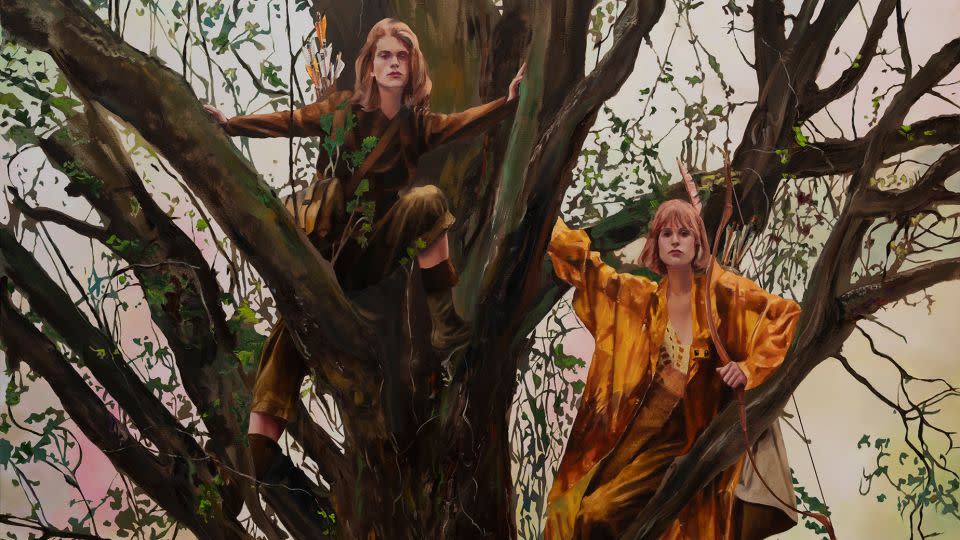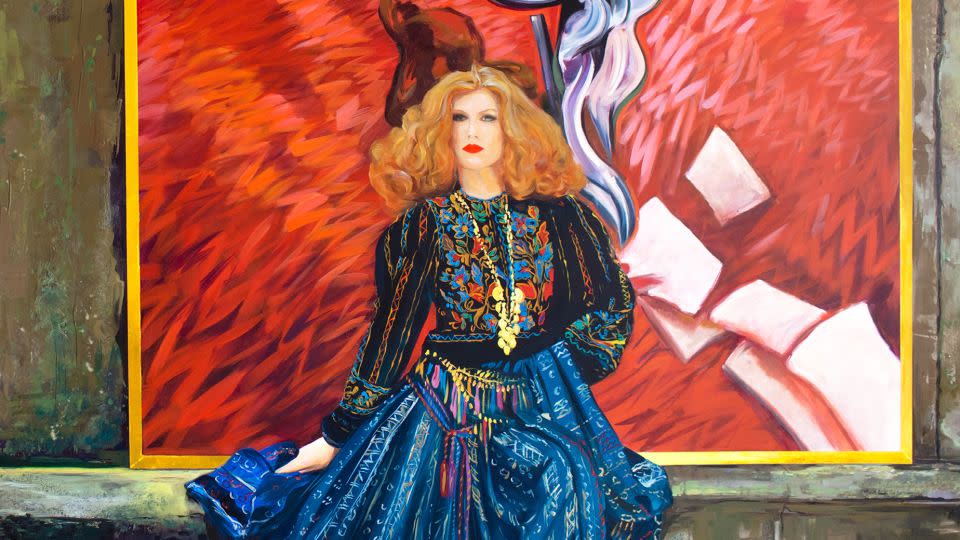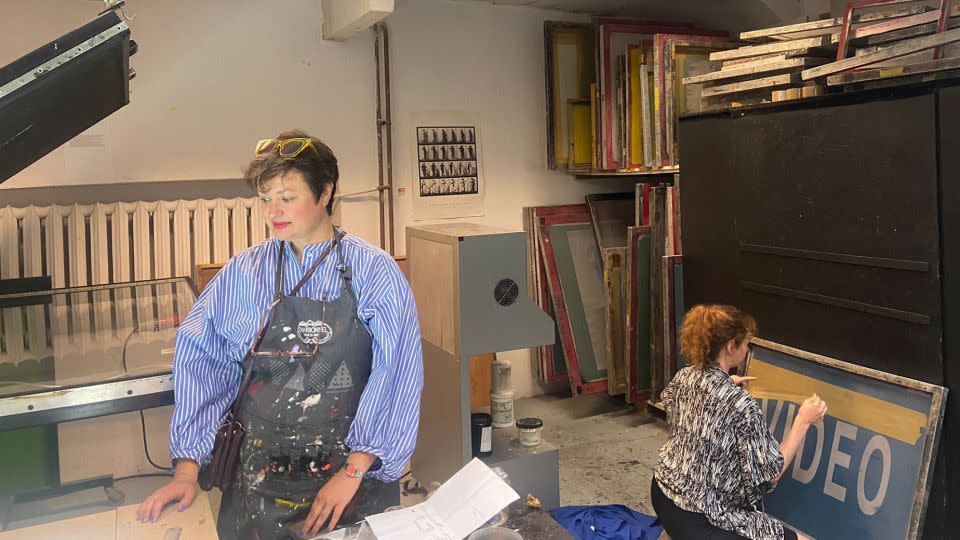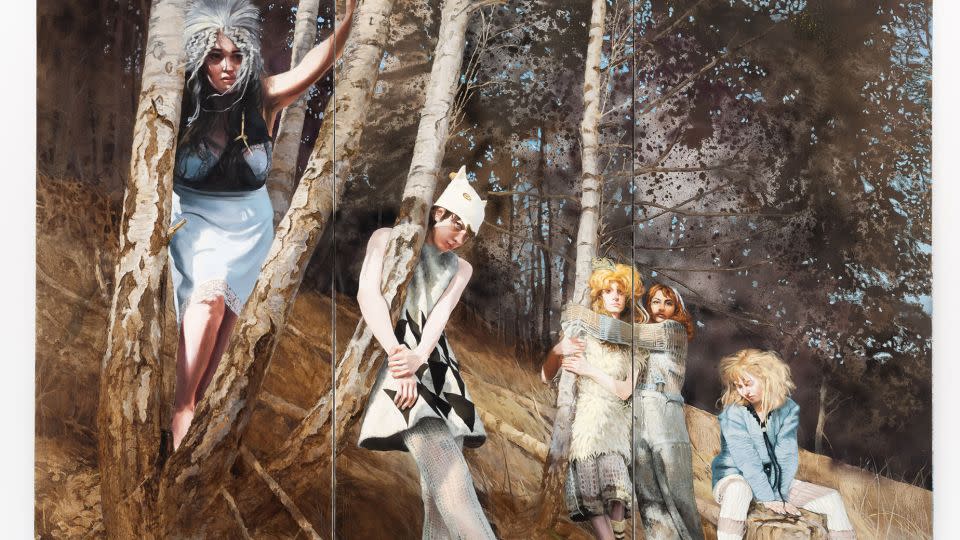Swamp demons, sweater patterns, wolf-tamers and Vogue: The intriguing inspirations of Paulina Olowska
In central London, moments away from the crush of Christmas shoppers on a busy street, a portal to a mystical forest has appeared. It takes you into Pace Gallery and upon stepping inside, visitors are greeted by the sound of birdsong, and surrounded by a series of woodland scenes on vast paintings, each inhabited by a curious cast of characters. Intricately carved wooden frames inspired by Black Forest cuckoo clocks reveal tiny video screens in which the same nymph-like figures come to life.
This weird and wonderful world is the vision of 47-year-old Polish artist Paulina Olowska. Perhaps best known for her fashion-inspired paintings of women that playfully juxtapose Eastern Europe’s socialist history with American consumerism, her practice also incorporates collage, sculpture, video, installation and performance. Already the subject of major museum shows including at the Kunsthalle Basel and the Stedelijk Museum in Amsterdam, her work was recently acquired by the Museum of Modern Art in New York. Currently, a solo show at the Fondazione Sandretto Re Rebaudengo art institution in Turin dovetails with her debut at Pace. It’s an encompassing exploration of femininity and folklore.

“I would never have made these paintings if I wasn’t living in the middle of the forest,” said Olowska, dressed in a vintage floral tracksuit when we meet. For the past 17 years, she has lived and worked in the Polish town of Rabka-Zdrój, 70km (43 miles) south of Krakow, towards Slovakia. “I like to choose places to live that reflect what I make work about. But when we first moved to the countryside, I was completely lost. I thought, ‘Well, what am I going to paint? Those pine trees?’”
She refers to her early work as “the modernism time,” when she was inspired by 1960s and 1970s ideas of socialism as well as the post-communist landscape of Warsaw — from the city’s neon signs to its sense of fashion. Her series of “sweater” paintings, for instance, use images from vintage knitting patterns — “Postcards I found at the flea market,” explained Olowska, as their starting point. But it was a project for the Berlin Biennale in 2008 that precipitated a shift in focus; looking at the work of the late Polish painter Zofia Stryjeńska, Olowska was struck by the way she combined modernism with “folk and Slavicness”.

These two elements increasingly feature in her own work. Slavic mythology is at the heart of the Pace show, titled “Squelchy Garden Mules and Mamunas.” The Mamuna is a female swamp demon said to live in thickets and feared for kidnapping human babies, but Olowska’s re-imaginings are less frightening, more feminist. They bring together elements of other folk tales — such as the wild, wolf-taming huntress goddess Dziewanna — in compositions inspired by fashion shoots for the likes of Polish Vogue.
A different way of working
“Paulina immerses viewers in her distinctive universe,” said Karine Haimo, vice president of Pace Gallery. Art collector Patrizia Sandretto Re Rebaudengo, founder and president of the eponymous art foundation in Turin, has been fascinated by Olowska’s work since she first met her in 2008, and has since bought seven of her paintings. “The first one I bought was based on a photograph by (British portrait and fashion photographer) Norman Parkinson, and is a blend of her interests in history, fashion and the construction of femininity,” she said over Zoom.

“For me, fashion is also a strong form of art,” said Olowska, whose new paintings at Pace were created from a series of photographs, produced in collaboration with fashion photographer Kacper Kasprzyk. The outfits which appear in the paintings, videos and on life-size sculptures (inspired in part by Polish Marzanna dolls that symbolize the Slavic goddess of winter, plague and death) were produced by Olowska and knitwear designer Monia Kucel.
Collaboration is a constant. At Pace, a pair of fantastical forest-inspired chandeliers are a collaboration with New York-based artist Jessica Segall. And in Rabka-Zdrój, Olowska has created a place of creative exchange at Artist House Kadenówka — a once derelict wooden house designed in 1930 by poet and amateur painter Adam Kaden, which she now runs as an artistic and cultural retreat, hosting exhibitions meetings, lectures and performances, as well as preserving Polish folk art and traditions. “Right now, we have a show of a very obscure, wonderful painter, Ludmiła Woźniczko,” said Olowska. “She’s in her 40s, but has never shown her paintings anywhere before.”

At Turin’s Fondazione Sandretto Re Rebaudengo, however, Olowska’s current exhibition tackles a different theme: Desire and eroticism from a female perspective. “Visual Persuasion” revolves around the question: “How do women want to think about sexuality?” said Olowska, who has positioned her own work (including a new installation of neons) alongside pieces by other artists from the Sandretto Re Rebaudengo collection — from Swiss feminist pop artist Sylvie Fleury to an installation incorporating a Fiat 126 car by Turner Prize-winning British artist Simon Starling.
“Paulina has a lot of energy,” said Sandretto Re Rebaudengo. “When we first started talking about a show, our first idea was to give her our exhibition area, but then she said she needed more space. She has used the galleries and the entrance; she took over the bookshop and the cafeteria, where she installed three new paintings. And then she said she wanted to do a performance, which she did in the restaurant. In the end, the whole Fondazione belongs to her exhibition. It’s fantastic.”
“Paulina Olowska: Squelchy Garden Mules and Mamunas” is at Pace Gallery London until January 6 2024. “Visual Persuasion” is at Fondazione Sandretto Re Rebaudengo, Turin, until March 3 2024.
For more CNN news and newsletters create an account at CNN.com

